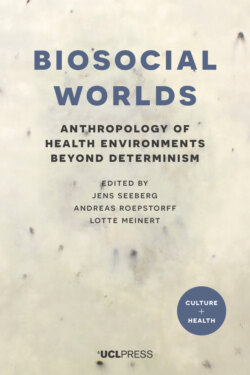Читать книгу Biosocial Worlds - Группа авторов - Страница 24
На сайте Литреса книга снята с продажи.
Agent Orange: Lasting effects in time and space
ОглавлениеBased on many years of fieldwork that commenced in 2003 in Hanoi, Vietnam, the Danish anthropologist Tine Gammeltoft has documented the devastating effects on reproduction caused by the chemical defoliant Agent Orange that persist more than 40 years after the war (Gammeltoft 2014). The US military conducted an aerial defoliation programme throughout the war that was part of a ‘forced urbanisation’ strategy designed to force peasants to leave the countryside where they helped sustain the guerrillas, and move to the cities dominated by US forces. Nearly 20 million gallons of chemical herbicides and defoliants was sprayed onto Vietnam, eastern Laos, and parts of Cambodia, destroying all plant material in 2 days. In some areas, toxic concentrations in soil and water became hundreds of times greater than the levels considered safe in the US (Schmidt 2016).
Agent Orange contains the highly toxic chemical dioxin, known to have long-lasting effects on the environment and human tissue. Gammeltoft documents a widespread fear about the so-called ‘dioxin gene’, widely believed by many people living in Vietnam today to be increasing in the population. It is estimated that at least 3 million Vietnamese citizens suffer from serious health problems due to exposure to defoliants, and the rate of severe congenital abnormalities in herbicide-exposed people is reckoned at 2.95 per cent higher than unexposed individuals. The media has reported cases of third-generation Agent Orange victims, in which individuals exposed during the war have produced apparently healthy children whose children are born severely disabled. Animal research has shown that, following fetal exposure, dioxin reprogrammes epigenetic developmental processes, the effects of which may become manifest throughout life and intergenerationally.
Vietnam was given membership in the World Trade Organization in 2007, one result of which was heightened concern by the Vietnamese government about the international visibility of the health of the population as a whole. It was at this juncture that extensive use of ultrasonography was introduced – a political tool designed to ensure the birth of healthy children. Ultrasound is now used repeatedly during pregnancy as part of antenatal care, even though the Vietnam Ministry of Health does not recommend this practice. Reaching a decision to have an abortion if a deformity is detected by ultrasound is not easy, particularly because many affected families think that abortion is an evil act. Everyone involved knows that it can be difficult to assess the extent of a deformity from ultrasound images, although it is equally the case that frequently it is all too evident. Some families, opposed to abortion, and longing for a healthy child, are raising three or four children with deformities, the most common of which is hydrocephalus (‘water on the brain’) that causes severe retardation. A few women discover very late in a pregnancy that their fetus is not normal, and some opt then for a late termination, to the great discomfort of their doctors.
Gammeltoft’s interviews with affected families make clear that many people choose not to entertain the idea that an anomalous fetus or the birth of a horribly deformed child is due to Agent Orange. They are all too well aware that the stigma attached to Agent Orange families ensures that finding marriage partners for healthy members of the family becomes virtually impossible. Better to claim publicly that the anomaly resulted from a common cold that the mother had, or the heavy work she did while pregnant (Gammeltoft 2014, 47–50).
A range of severe illnesses are associated with dioxin exposure, including deadly cancers, Parkinson’s disease, and spina bifida, in addition to those associated specifically with pregnancy. Vietnamese researchers have reported these findings, but the official US position is that there is no conclusive evidence that herbicide spraying caused health problems among exposed civilians and their children. However, following extensive lobbying over many years, in 2014 the US Congress passed a five-year aid package of $21 million that amounted to a modest sum for each US veteran of the Vietnam War. These cases were settled out of court and no legal liability has ever been admitted. The official position to this day is that the government was in effect prodded into settling these legal suits and that no evidence exists that Agent Orange caused harm, and this position is supported by its principle makers, Monsanto and Dow Chemical companies. Children born to Vietnam War veterans who have birth defects may be eligible for compensation that varies according to the perceived level of disability.1
In Vietnam, officials were reluctant to press complaints about Agent Orange because uppermost were concerns about the economy as a whole, notably a desire not to damage the marketing of numerous agricultural and aquacultural products made in Vietnam today. In the mid-1990s, Vietnamese writers and artists began to express concern about Agent Orange, and eventually Vietnamese citizens filed a class action suit in the US District Court in New York that was abruptly dismissed. However, belated demands for responsibility are increasingly being heard, spearheaded by non-governmental organisations. In summary, local biologies not only persist across generations; they also travel through space.
